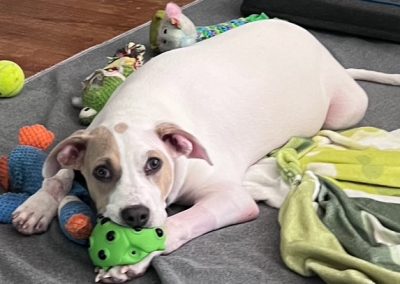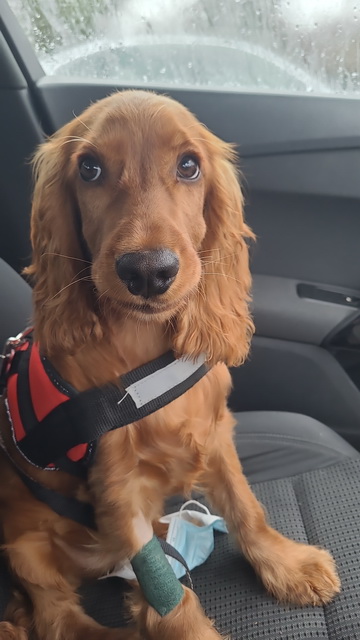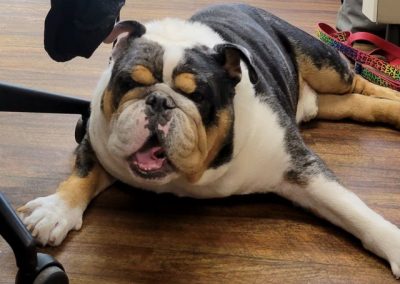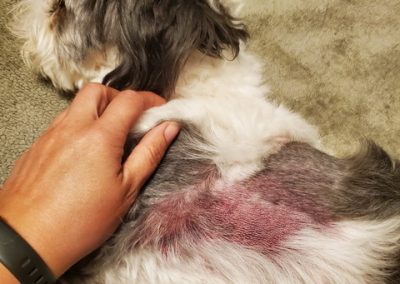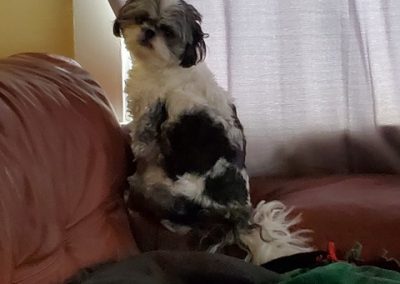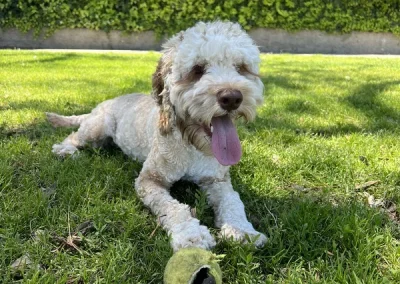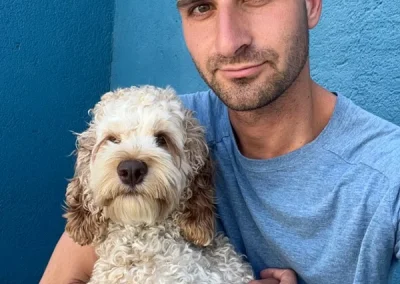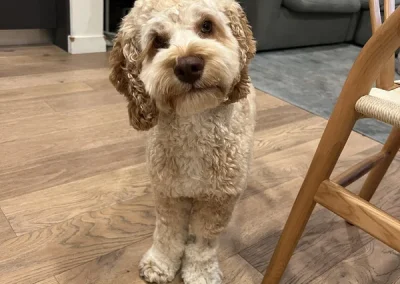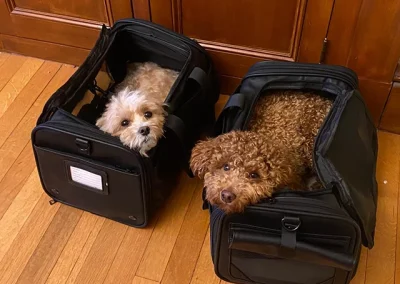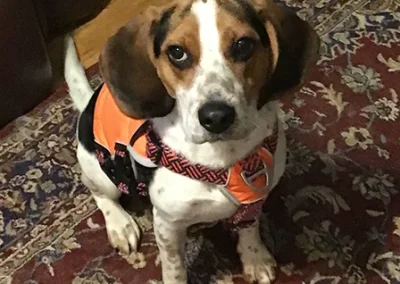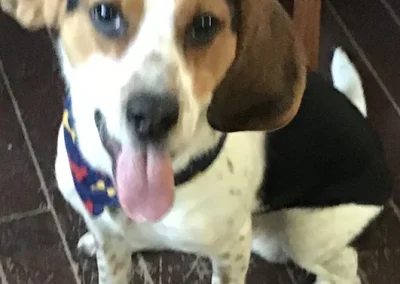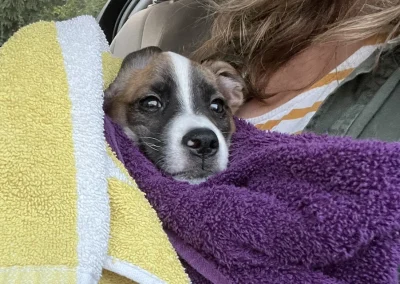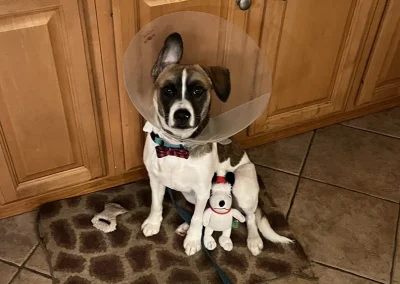Stories
After fostering many, many puppies, “Andy”…
…(affectionately named after one of his favorite television hosts, Andy Cohen), is my first foster fail.
I picked him up in an abandoned Cheesecake Factory parking lot on July 3rd , as the rescue I volunteer for was short on approved fosters during the holiday week. I was told he was surrendered after a neighbor called to report an accidental litter of puppies that had been locked in a crate for the first 6 weeks of their life and wouldn’t stop barking. After having an obsession for many years with our family’s German Shepherd at my parents’ home in
Memphis, TN, I knew it was time to accept “failure” and finally adopt one of my own.
Andy is a typical GSD puppy with a lot of energy, dominance, drive… and drama! He is intelligent, excited, loving, and loyal as can be, and he doesn’t have a mean bone in his body. He loves to hike in the Colorado mountains, give kisses on the job to customers at his Pure Barre studio, and keep his 11-year-old Frenchie sister, “Oprah,” on her toes.
During a work trip, I left an almost 9-month-old Andy with a well-recommended family that runs a small, 4-6 dog day care at their home. While he was there, I was told Andy was “on 10” and engaging in a lot of rough housing, excited for so much time with young, fun, big dogs. When I picked him up, I could tell he was tired, but nothing too crazy. That night, I was giving him pets and noticed that hard, tender grape to golf ball sized lumps had formed on either side of his rib cage. He squealed when I went to help him into bed. I made a mental note that we would go to the vet first thing if he hadn’t improved in the morning.
During that time, Andy deteriorated significantly. I felt I was literally watching him die in front of my eyes. I got the doctor’s attention, and as soon as she reviewed his bloodwork, she started calling ERs to see who had plasma available. We were admitted to an ER vet, where it would take 3 plasma infusions and 1 red blood transfusion to stabilize Andy. The vet on-call the afternoon we arrived was named Dr. Fox. She sat with me and calmly discussed coagulation disorders and was open about her personal experience with her own puppy that had Hemophilia A. What are the
odds?!
Andy struggled through the night, so, the next morning, Dr. Fox called and recommended he be transferred to Colorado State University Vet School in Fort Collins in the event he may need platelets, further blood products, or more specialized care. CSU kept him stable without additional transfusions, though he still had a lot of bleeding pooled into his muscular and subcutaneous layers. They did a CT to rule out cancer and broken bones. Two days later, I was able to bring Andy home; and in a couple more, we got the tests back from Cornell that confirmed that Andy is positive for Hemophilia A.
Andy and I are working hard to process his diagnosis and learn about our new normal. Andy is a fighter, and we are both endlessly grateful to Dr. Revel and her colleagues for the support,knowledge, and hope they provide to this community of special pups and owners!
Meet Sonny: Our Brave and Loving Pittie Mix
Sonny is an 8-month-old pittie mix with the kindest spirit and an incredibly tolerant nature. We rescued Sonny to be a companion and playmate for our 3-year-old pittie, MayBelle. From the moment they met, MayBelle knew that Sonny needed gentleness and love, and they quickly became inseparable friends.
When we first brought Sonny home, we believed he had an autoimmune disorder affecting his joints and hoped he would outgrow it to live a healthy life. However, after a severe joint bleed that nearly cost him his life, we discovered that Sonny was actually suffering from hemophilia A. By then, Sonny had already stolen our hearts, and we entrusted his care to the amazing team at PASE in Philly, who saved his life and helped us develop a plan to manage his disease.
Despite our best efforts, Sonny experienced another major bleed, this time in his chest. The outlook was grim, but Sonny’s charm and resilience, which we call “the Sonny effect,” won over everyone at PASE, and they saved his life once again.
Sonny is truly special, embodying pure love and joy even on the toughest days. Some days he needs complete rest and assistance walking, while other days he is eager to play like any other puppy, even though we have to find safe ways for him to expend his energy. Despite his limitations, Sonny has the best personality. He is sweet and cuddly, spunky and curious, persistent, and has the world’s best head tilt!
We know that our dogs’ lives are never long enough, but we hope that with the help of veterinary research and clinical trials, Sonny and his fellow hemophiliac friends can enjoy lives filled with the freedom to play, roam, chew, jump, run, wrestle, chase baseballs, and do all the things that fill their dreams.
This is our gorgeous boy Tommy who will be 2 this October!
We got Tommy at 9 weeks old, three days before Christmas. He was a normal little puppy and full of life (even crazier now!).
We have two cats, who weren’t very keen on Tommy at first, and one of them scratched his ear. It bled for ages and we brought him to the vet who bandaged him up and said ears bleed a lot so no real concern.
Then, when he was teething he used to bleed excessively. He would fall asleep and wake up in a little pool of blood under him. Since he was our first puppy we thought this was normal at first. But it continued for a few days and we took him to the vet, who referred us to UCD vet hospital in Dublin, Ireland.
They kept him overnight and did tests on him and he was diagnosed with Hemophilia A,. We weren’t told much just that if he had a bad bleed he would need plasma.
Where we live in Ireland, vets don’t have any access to cryoprecipitate or plasma, so if he has a significant bleed the only supply of is hours away in Dublin. Our vets told us there is no treatment, meds anything available and just to hope he doesn’t bleed out before we get him help!
We love him so much and he is such a happy boy. We hope we can someday access gene therapy for him so he can live a long, happy life, free of the painful joint bleeding that he currently battles from time to time.
Ivar was surrendered to me by his breeder as a 4 month old puppy…
…who had lost mobility in his rear end and was not responding to medication or laser therapy as I worked with our local English Bulldog Rescue. I offered to foster since the veterinary clinic I work for has an orthopedic surgeon. Despite being covered in urine scald and burns from his previous laser treatment, he was the happiest, most outgoing puppy. He continued to have occasional joint swelling and be non-ambulatory. Radiographs and routine lab work results were inconclusive. He as given hyperbaric oxygen treatment for the swelling with no results. After a visit to a neurologist, additional testing and an MRI were recommended. While waiting for this appointment, he continued to be non-ambulatory and have random joint swelling. Then a few days later we noticed an excessive amount of blood in his kennel after he had been playing. The only thing found was a baby tooth. Suspecting a bleeding disorder, an in house pt/aPTT was run and a sample sent to Cornell for testing which confirmed Hemophilia A.
So little is currently studied about dogs with Hemophilia, that Ivar was given a guarded 6 month prognosis and spent the next several weeks completing a bucket list of fun puppy activities. 5 ½ years later, he’s defying the odds and living his best life. He has needed two transfusions of Cryoprecipitate for major bleeds. He has also had numerous small bleeds, some random and others caused by his zest for life and his no fear attitude. After his first transfusion of Cryoprecipitate at just one year old, he stood up and walked and has been mobile ever since. We are hoping for many more years to come.
We got Vini when he was three months old.
We first noticed something was off when he would not put pressure on specific legs, but the vet would prescribe medication, and it would get better. He also bled a lot when he was teething.
The big bleed which led to his diagnosis took place when he was about a year old. He developed a mass under his tongue, and the emergency vet performed surgery. They had no idea what the mass was. He was not healing from the surgery. He stayed at the emergency vet for three weeks and had three blood transfusions. They could not figure out why he was not healing. One of the vets thought maybe he had a bleeding disorder and asked us if he wanted to test to see. Well, the test came back positive for hemophilia. They got information from Cornell and said we could give him cryoprecipitate and see if that helps. He started getting better with the cryoprecipitate! He came home with a feeding tube, and it took a couple of weeks of home care and a few rounds of cryoprecipitate before we felt like he would make it. The vet told us he would probably not live to see five and give him the best life we can in the short time that we have him.
Vini has lived for over 11 years. He will be 12 in October. Vini has had a lot of bleeds over the years. We always keep multiple bags of cryoprecipitate in the freezer. We have had to completely adjust our lives and spend a lot of money to care for him, but he is worth it, and I am thankful for every day I get to spend with him. He is the best dog in the world and makes our lives whole.
Walter was dropped off to a rural shelter in Nebraska…
…on a busy Saturday in early 2022, in a box, with a little Japanese Chin friend. No information was left about them. He was vetted by the shelter vet and when he was neutered he had bleeding complications. Out in rural NE he wasn’t able to be provided with any blood products, but somehow survived that surgery and was in recovery for 6 weeks. The shelter had put a teaser photo up of the pair of dogs prior to them being adoptable and since I had been looking for another Japanese Chin I called them and got approved to go meet them that weekend. They both came home with me the weekend of Easter in 2022 with a warning that “he bled a lot and it was weird.” In August of 2022 Walter presented at bedtime painful with fluid on his rib cage. Having worked around animals and dogs for over a decade I knew something wasn’t right and took him to urgent care.
That began our adventure of discovering that Walter had Hemophilia. He’s since had four additional bleed events and has also had a few seizures. We’re not sure how the seizures fit into this picture, but we’re hopeful that maybe they’ll go away after he’s able to have Gene Therapy. Walter is now three years old. His two best friends at home are Fiona (his Japanese Chin buddy) and Becca (a 60 pound lab/pit mix). Walter loves playing with his sisters and I look forward to the day that I don’t have to be the fun police and end playtime when the be-bopping off the furniture gets too intense.
Roland’s Story
Jack and I stared helplessly into the oxygen chamber where Roland tried his hardest to breathe. He was still fighting, but the light in his eyes was dimming. Over 60% of the blood in his body was pooled in his lungs. Even if they were able to save him, something like this could happen again in a week. He was still just a puppy, and was only a month away from his first birthday. He’d already been through so much, and this third trip to the ER was not boding well. “He won’t feel anything or know what’s going on, I promise,” said the vet, who had been very familiar with Roland’s case. “He’s just been dealt a really unlucky hand.” My Dad had just pulled in, his eyes teary, to come and say his goodbyes. We all sobbed. I knew it was time, but Jack didn’t think we were clear-headed enough to make the decision. I agreed. Besides, it was a Sunday and I had no way to reach our primary vet who was so invested in Roland and his condition. I sent an email to the office, but hadn’t heard back yet. “I can’t make this decision without talking to Dr. Revel. I owe it to her.” So we told them to go ahead and drain Roland’s lungs…
When my boyfriend Jack and I welcomed a new puppy, it was love at first sight. He was crate trained within weeks, loved to snuggle, and had the most incredible temperament. Roland brought Jack and I even closer together – and not just because we named him after the Roland Garros tennis tournament, a sport that we had bonded over being superfans when we first met. Besides the limps that Roland got every few weeks (which we chalked up to growing pains) and the relatively excessive bleeding when he lost his baby teeth (which made him look like a vampire for weeks on end), Roland seemed to be pretty normal. After a quick visit to the vet to make sure one of his limps wasn’t anything to worry about, the vet on the team who saw him that day and hadn’t met him before made a point to personally come tell me “you have a really special dog.” Little did we all know what that really meant. Everything changed the day Roland went in to get neutered.
I dropped him off early in the morning and was expecting to pick him up midday. That’s when I got a call from Dr. Revel. She said she needed to put Roland back under anesthesia so she could go back in and re-sitch him up because his wound kept bleeding. When I was finally able to pick him up, she warned me that the bruising was bad. She also drew some blood for additional testing just to be safe, told us to monitor the wound carefully, and to let her know if there was more bleeding the next day. The next morning, there was a hefty amount of blood that had pooled in his crate. I called Dr. Revel and she picked up immediately. “I was just about to call you.” She had already gotten the blood work back and after doing some research had a hunch Roland had hemophilia– a rare blood disorder in which he lacked a critical clotting agent.
We immediately took him in for a transfusion, and for the next six weeks, we nursed Roland back to health. We set up our terrace with grass for him to do his business and administered a complicated medicine schedule. This included putting cream on his scrotum every few hours and lubricating his penis which kept drying out because he wasn’t able to groom it – not things I saw coming when I signed up to get a dog. But he still found ways to aggravate the wound by dragging his behind on the ground and using the cone, which only aggravated it more. The first morning that Roland woke us up with a bark was one of the happiest days since we got him. He was back, and we could start resuming our usual routines, albeit with a lot more caution.
The ER had told us that we should be treating him like a glass animal. At the same time, before this incident, Roland was going to the park, playing with other dogs, and chasing tennis balls. We were optimistic– we just had to keep an extra eye on him and bring him in to get a transfusion if he ever got a cut or something. It seemed reasonable enough.
But just a few weeks later, days before the winter holidays, Roland became lethargic and was breathing heavily. I soon discovered that the entire area under his tongue was swollen, and he was struggling to eat or open his mouth. So off to the ER we went. Roland punctured his mouth somewhere under his tongue. It kept swelling and they were worried it would soon close up his airway. He soon also wasn’t able to eat or drink on his own. This is when both the ER and various family members started to weigh in on the long-term viability of keeping Roland alive. If these incidents were to keep occuring, would it be fair for Roland to suffer? Was it fair for me and Jack to be constantly worried? And that didn’t even touch upon the costs involved of keeping Roland alive. I must have had a premonition of some sort because before I got Roland, I purchased him a health insurance plan that covers 90% of his medical bills with a very low deductible. Each of these ER visits were nearing $10,000 apiece – with Roland quickly racking up over 20 nights in the ER – and wasn’t something we would be able to otherwise afford.
Besides the neuter, which was elective, this was the first serious incident. We savored every moment Roland was healthy, and we tried to maximize each day he felt good. This included resuming training, which was tricky given that we could go weeks without reinforcing what he learned because of him being ill. And when he was fit, we would find ourselves being lenient with him because we felt badly for him and his condition. Everyone has a special bond with their dog, but I don’t have the words to describe the connection we have developed with Roland. It’s like he knows what he’s been through and that we’ve been there for him. The way he looks at us when he’s not feeling well, and the forlorn eyes he gives us when he is whisked away at the ER are so piercing.
There weren’t many good days before the next incident. Here we were, less than a week after Roland had fully recovered (minus full mobility of his tongue), back at the ER with his lungs full of blood, helplessly staring at him in the oxygen chamber. As we got home after deciding not to put him down, we got a call from Dr. Revel, who apparently checks the office email on Sundays. We told her what they wanted us to do but that we couldn’t make that decision without her. At this point, there had been mention of an experimental gene therapy trial that was conducted almost a decade ago that proved highly successful on dogs with Hemophilia A. Unfortunately, the ER vets told us that they had inquired about the study and that it was fully closed and completed. But Dr. Revel said she would reach out to them herself.
A multiple months-long journey of getting this study approved had begun. While we were excited and cautiously optimistic, we couldn’t help but feel some extra stress knowing that while there was potentially a light at the end of the tunnel, something could happen to Roland at any moment. During these months, we lost two of the dogs who were intended to be in the study – one of them not even three years old. The thought of losing Roland so close to the finish line was a terrifying thought.
As we push through the final steps of this path forward, all we have left to do is secure grants and fundraise so that we can save as many hemophiliac dogs as we can. This whole journey has been one of the craziest things I’ve ever been through, and Roland’s story is hopefully just beginning. I didn’t sign up for this – I thought I was getting a healthy puppy. But everything happens for a reason and I truly believe Roland was meant to come home with us. I wouldn’t change anything. He’s taught me so much about resilience, and I’ve learned how to be more calm when things get hard. Life is full of ups and downs, and Roland has helped prepare me for what’s to come. I’m so grateful to everyone involved for their dedication to save Roland and his friends. Let’s get this over the finish line.
Thor was the cutest puppy I had ever seen. In 2015 it was love at first sight for me.
I noticed Thor was different as a puppy. As he lost teeth, he bled all over the toys. I thought this was a small dog trait as I had never owned a tiny little dog before.
Thor was so sweet and friendly but became stormy and moody for no apparent reason. I took him to the vet and consulted with a behaviorist. They all told me he was too young to be so feisty (I know now he was probably bruised/bleeding, and I wasn’t seeing it.)
We realized he had hemophilia after he was neutered; when I picked him up from his neuter, he was not acting correctly. I kept an eye on him all night and he never came out of his crate, when I finally coaxed him out in the morning, I saw his whole underside was bruised and bleeding. I rushed him back to the vet that had done the procedure. This vet was not a large emergency clinic or multi-vet practice, he was a local vet with an office on the side of his house with an excellent reputation that had treated all my pets for many years. (I honestly didn’t even know what an emergency vet was). He told me immediately he felt Thor was having a bleeding issue and he would admit him to his home-based hospital and do the best for him. He sent lab work out to Cornell University (the only lab that does tests for canine hemophilia) and cared for Thor as if he had hemophilia because he suspected it.
I took Thor for a second opinion to a University of Penn trained doctor where the vet told me Thor would have a short life and expensive life. She told me he would never survive a lung or brain bleed. She asked me if I wanted him put down–as he was peppering her face with kisses. She did not feel there was any hope.
I was adamant that he was fine (I mean he looked fine) and brought him home. I tried to get pet insurance, but genetic disorders aren’t covered. My husband and I started a savings account so we could be ready because I was going to do whatever Thor needed us to do to keep him with us.
Thor didn’t have another bleeding issue again until 2017, which was a blessing. But if you know Thor, his motto is “Go Big or Go Home” (typical little dog syndrome) and his ‘first” non-surgical bleed was a doozy. On a Friday before New Year’s Eve, yep holiday weekend… Thor started acting funny. I took him to the vet and asked flat out “can dogs get headaches? I think he has a headache.” They sent me home.
Once he was home it all began again! I took him back and they gave him more plasma. It was during this time I hit the internet hard and found that there was a colony of dogs in North Carolina, at a university for study. I reached out to Robin Raymer, who immediately came to our assistance with her experience caring for dogs with hemophilia. The vet at the ER took what I had found and called Robin herself. That was when Cryoprecipitate was first given to Thor and my true education on how to advocate and take care of a dog with hemophilia began. Thor spent another week in the hospital, but recovered fully from a brain bleed, origin unknown. Truly another miracle.
Thor had a bout of bleeds in late ’17 and early ’18. It was the best season the Philadelphia Eagles had played in a long time and every time they won a game, I was in the hospital with Thor. In Philly, Eagles fans “bleed green” and the joke around our house was Thor was doing just that! (I try to keep some humor as this can be so devastating). The night the Eagles won the Super Bowl I picked Thor up during half-time! He had various bleeds for various reasons, he slipped on ice, he bruised his kidney, he had a stomach bleed, and groin bleed….off to the ER we went. We were really lucky to have the same vets at this ER that knew him.
I have learned there are tools the vets do not know about like tranexamic acid, and when given early in a bleed can sometimes stop it. I keep cryoprecipitate in my freezer because I can buy it cheaper than the ER sells it, and they do not usually have it stocked. (This requires having a generator for my freezer). I know keeping Thor safe is something you have to give thought to, he cannot do what other dogs do, he cannot play or rough house and I have had to be creative in how to get all his boundless energy out without him getting hurt. I have to watch what toys he has access to as bones and things can quickly become sharp and cut him.
Thor is 9 years old as of this writing in 2024.
Teddy’s Unbreakable Spirit and his Journey Through Hemophilia A
We welcomed Teddy into our family when he was just 8 weeks old. From the start, he was a bundle of joy, instantly bonding with our two children and our 3-year-old Maltipoo, Lola. Teddy looked up to Lola as his best friend and followed her everywhere…he still does.
It wasn’t until Teddy turned one that we discovered he had severe Hemophilia A. In hindsight, there were subtle signs, but the diagnosis was challenging to identify. First, when we clipped his nails, he bled more than expected, and no one could explain why. Then, he had several trips to the emergency room after suddenly limping, though X-rays showed no broken bones or obvious injuries. One day, we came home to find fresh blood on the floor from what turned out to be just a small scratch on his ear. The most alarming incident came when we returned from a weekend family vacation in January. Teddy and Lola had stayed at a pet hotel, and when we picked them up, we noticed a large purple hematoma on Teddy’s belly.
Teddy is only 20 months old now, and despite everything, his resilience and spirit never changed. He experiences frequent episodes of limping, which are now unfortunately a regular part of his life, but his playful, affectionate nature remains unchanged. Every morning, without fail, Teddy howls to greet us, his own special way of saying hello. He radiates love and joy, even on his toughest days, and we are devoted to making his life as happy and fulfilling as he makes ours. He’s absolutely adorable, and we will do whatever it takes to give him the best care and support.
Scout’s Story
It was starting a hemophilia support social media page that actually brought Scout into my life. After spending greater than 26 years treating hemophiliac dogs, owning and operating LifeStream Animal Blood Bank in Canada, I guess you could say, Scout and I are, “a match made in heaven.”
Scout lived with the loving family of a kind woman named Sarah Jo in New York. At the age of nine weeks, he suffered a life threatening emergency, and was treated at Cornell University. He was diagnosed with Hemophilia A and a canine factor Vlll level of only 4%.
Seeing a post about Scout, with his adorable picture, I reached out to Sarah Jo inviting her to the support page. We began corresponding. Distance was a factor in Scout receiving the treatments needed to manage his hemophilia. Sarah Jo asked if I would adopt Scout.
On Mother’s Day weekend May 2023, Sarah Jo travelled with her mom, to my home in Ontario, Canada, crossing the border to bring Scout. There were many tears that day. I guess you could say he has dual citizenship, and is very much loved by both of our families. I am in regular contact with Sarah Jo, to update her about Scout.
Scout is a fun loving, rambunctious beagle with a big heart. He has become an ambassador for Canine Hemophilia. He has attended pet expos with me and educational seminars, to help veterinarians, veterinary technologists, and pet owners, learn about bleeding disorders.
Alfie’s Story
In July 2023 we adopted a 12 week old runt of the litter that we affectionately named Alfie. He came to us looking a bit like a Norwall and fit right in to our family.
Within a week of his arrival, his cheery disposition shifted, and he started to look a little wobbly. Just shy of 24 hours later he lost all use of both back legs and had no deep tissue response to his paws. The second emergency care that we went to, knowing it offered ultrasounds, revealed a mass on his spine and the prognosis was grim. The vet said, except for a miracle we would likely be taking him home for one last night and suggested we consider compassionate, euthanasia for our little guy as a realistic option.
With tears in our eyes as our family listened to this conversation on speakerphone, I assured the vet that we had plans for Alfie to wear a red bowtie under the Christmas tree, and this couldn’t possibly be the end of his story with us. We took him home loved him up and tried to prepare ourselves to say goodbye to our little guy. The next morning, much to our astonishment, Alfie awoke and was trotting along once again. When we called the vets to alert them of this great news, they shared that they had actually extracted some fluid and with our permission wanted to send it off to UC Davis for further studies expecting it was some sort of rare parasitic mutation. The test came back clear. We were left scratching our heads but grateful for this recovery.
In the weeks following that our resident dog took ill and we had to say goodbye to her just two weeks later, leaving us with little Alfie missing his sister. As the months went on, Alfie would present with non weight bearing episodes that occurred for no apparent reason although his one leg was typically affected, we noticed all legs having these random non weight bearing episodes . We got him scanned and found that he had hip dysplasia. Hmm, perhaps that was part of a problem that was calling him some issues?With each vet visit, we all scratched our heads and remarked what an unusual dog he is.
His six month time to be neutered came on the calendar and his vet suggested we wait a little bit longer just to give him some more time for his second testicle to drop – a more invasive surgery was not ideal. As December approached, we decided to schedule him to be neutered, hoping for the best. He had been a perfect angel as we decorated the tree, handsome as ever donning that red bow tie we envisioned.
The day of his surgery, a call from the vet revealed he was having some bleeding issues and so they went back in to check things out but everything looked good and we should give him a little more rest before picking him up; however, when we got to the vet he was still bleeding through the bandages and they suggested we rush him to the ER.
Back, we went with our special guy. His numbers were absolutely horrible and we were faced with another reality check that we might lose him. We approved the blood transfusions and cryoprecipitate along with a few days in the ICU. He finally was back on his feet. The bruising was horrific, but his numbers had stabilized.
When his tests came back, it revealed his Hemophilia A Factor VIII with clotting factor of less than 1%. We would need to basically keep him in a bubble they said & suggested we never have other dogs in the house with him for fear regular dog play could become a life altering event for him. Our home had been one where we fostered puppies for years, and after losing our two resident dogs in 2023 our hearts were already torn apart and now this! Poor Alfie.
With the scarcity of published medical papers on canine hemophilia, these next months were tricky at best . No treatments, no medicines, just hold your breath and hope that his next flare up won’t be his last. One particular flare up resulted in non weight bearing for over a month that led to such severe atrophy & bruising we wondered if he would regain use of that leg altogether.
At last we, we found a canine hemophilia support group, and we have been making great strides ever since . As of Oct. 15, 2024, he is eighteen months old. We are always cautious with Alfie, but are happy to report he has a big brother therapy dog. He’d never believe you if you told him he is short of perfect. We are so hopeful that gene therapy might help him live his best life, unfiltered, red bowtie and all for many years to come.
In Memory of Zoto
My husband and I adopted a Husky/Shepherd puppy who was surprisingly born on our wedding day. We named him Zoto (which means “gift” in Japanese). He was the sweetest-happiest puppy who thought every walk of life was his best friend.
Zoto was diagnosed with Hemophilia at four months old. He had a genetic disorder that hindered him, but it never kept his spirit down. I was previously a vet tech for over a decade, but this was my first interaction with hemophilia in a dog. There were so many questions, and very little answers at first. It wasn’t until we met two amazing people: Sandra and Robin from an online support group for canine hemophilia, that we were able to learn so much about Zoto’s disease. We stayed as optimistic as one can with this disease. We let Zoto live his BEST life! Despite the challenges we would
face. He was too happy of a dog to be stuck in a bubble. We did hydrotherapy, massages, and physical therapy. Zoto even enrolled in agility!
Sadly he passed away at the age of 21 months, but within his short life he went to five different states and traveled internationally to Canada! We
kept that sweet boy by our sides and carried the largest first aid kit wherever we went. The gift that Zoto brought to us and everyone that knew him was to live every day like it was the best day! He was the silliest, happiest boy who never knew anything was wrong with him. We can only wish to carry on his legacy by helping all his Hemophilia Hound friends.
The day has come for all these other amazing pups and families to finally find some relief with this disease. Please help us and donate to the Hemophilia Hounds organization, so that we can get these gene therapy trials started. We were so hopeful for the day that genetic therapy would be available for our sweet boy, but donating would be the greatest gift we could give back to our Zoto. Please think of donating, Matt and I will be making a donation because we would have done everything in our power for our sweet boy Zoto.













